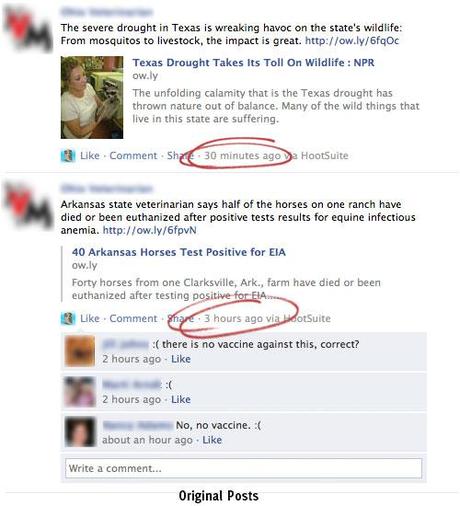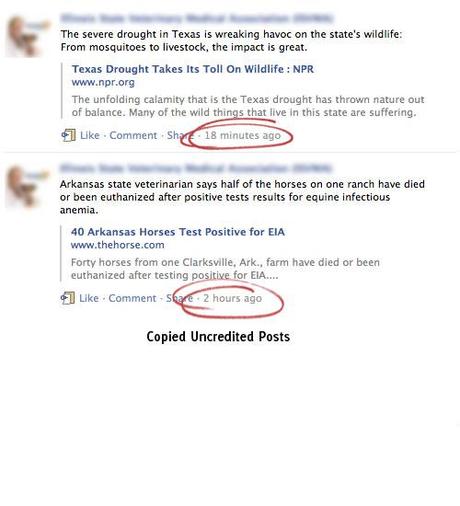
Don't make a mess of your social media strategy.
All right, you got me. I’m not Miss Manners. I can’t help you with the most polite way to decline a tea party invitation, or decide what time of day it is appropriate for a woman to wear pearls. Of course, if you were interested in either of those things, you probably wouldn’t be here.
So, gentle reader, instead I am going to give you some advice that will improve the quality of your online social networking. You might think you’ve got Facebook and Twitter down pat, but if you’re doing any of the following things, you’re in for a rude awakening.
1. Don’t steal other people’s posts without giving them credit (especially when you’re copying and pasting their exact words).


As a writer at heart, I feel very strongly about this one. Plagiarism is never cool. In fact, it’s kind of smarmy. You may get away with it once, twice, even 100 times. But eventually, your luck is going to run out, and you’re going to get in trouble. Depending on the severity of your offense, it could be more than just an irate Facebook friend. So what do you say we avoid trouble and foster positive online relationships by giving credit where credit is due?

Give credit where credit is due.
Thanks to handy Facebook tools, giving your original source credit is really easy to do. In fact, it’s easier than stealing. If you see a link someone else posted, and you think your fans would like it, all you have to do is click “Share” underneath the post. In the box that pops up, type in your message and simply DO NOT remove the original author! What could be easier than not doing something? When you are finished, the post will appear on your profile with a little note that says “via (original author).”
And on Twitter, we all know all you have to do is click “Retweet.” If you want to add your own comments (which, unfortunately, Twitter does not allow you to do when retweeting) or change the Tweet entirely, just add in the original author yourself with a simple “via @User” or “MT @User” before posting.
Viola! You’ve shared the post… and as an added bonus, you’re going to make someone happy that you’re sharing their work with other people — instead of angry that you’ve essentially stolen their post.

If you want followers, be willing to give them something in return.
2. Don’t follow just to get follows.
The number of people and businesses on Facebook and Twitter is astounding. In fact, I am pretty sure it’s somewhere around a thousand million, give or take a few. Point being, it’s a lot of people, so it’s really easy to find Facebookers to like and tweeps to follow.
Many social media amateurs go on a follow frenzy with one goal in mind: To get those people to follow them back so they can barrage them with shameless self-promotion. These individuals have no intention of putting any thought into their social media “plan” or giving their new followers something useful to gain their trust. Rather, they believe that because those people are polite enough to follow back, they’ve done as much work as they need to in order to convince them to become customers.
Nothing could be further from the truth. Look at it this way: Just because I walk into your jewelry store doesn’t mean I’m going to buy anything. You’ve still got to make the sale. That requires finding out what exactly I’m looking for, what my budget is, not pressuring me, and establishing a rapport to get me to trust you in this context — in other words, it takes work. Social media is no different. If you want to get something out of it, you’ve got to be willing to put something in first.
3. Don’t unfollow people you follow when they don’t follow you back immediately.
If you’re like me, you’re not on Facebook and Twitter 24/7. After all, I’m just one person, and I have other things to do than follow people back 30 seconds after they follow me, all the live-long day. True, in my line of work, I am often in front of a computer, but I am also working on other projects. I tend to save (that is definitely a euphemism) my Twitter notifications til the next morning or, during particularly chaotic times, the end of the week when I have fewer distractions.
It’s not an uncommon occurrence to see one of the users I followed back yesterday start following me — again! — after I return the favor. What this says to me is that you weren’t really interested in having me as a follower (read: client, customer, source of income, etc.) and were just mass following people. You got impatient and, when I didn’t follow back immediately, you unfollowed me. Then, whoops, when I started following you (better late than never, eh?), you had to start following me. Again.
Not only is this follow-unfollow-follow-again process inefficient (and rude!), but it’s the antithesis of social media. Guess what? Getting results from social media takes time. It doesn’t happen overnight. Obviously if you’re not willing to wait a few days for a follow back, you’re not willing to put in the time needed to get results — and believe me, with that attitude, you won’t. Unless you revise your social media “plan,” you might as well throw in the towel now.
Stay tuned for part 2: What you SHOULD do as part of your social media plan.
Talk back…
What don’ts would you add to the list of social media etiquette no-nos? Share your own Miss Manners-esque advice in the comments!

